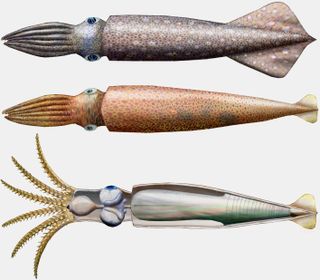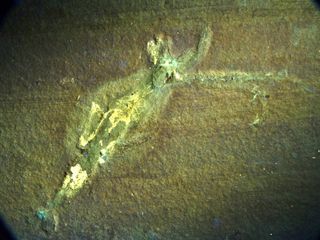Jurassic 10-Armed 'Squid' Were Speedy Swimmers

Three extremely rare fossil specimens of an extinct squidlike animal provide new evidence of the 10-armed creature's body structure and suggest that it may have been a swift swimmer, a new study finds.
The fossils represent Acanthoteuthis, a genus of squid relatives that lived during the Jurassic period and measured between 9.8 and 15.7 inches (25 and 40 centimeters) long. What makes the specimens so exceptional is their preservation of soft body parts like the animals' fins and feeding structures, which are usually lost to time. Now, an analysis of the new material reveals never-before-seen organs, offering scientists their first glimpse of features that suggest how Acanthoteuthis may have lived, millions of years ago.
Acanthoteuthis is a cephalopod, part of the ocean-dwelling group that includes modern octopus, squid and cuttlefish, with an evolutionary history spanning 500 million years. But even though cephalopods have been around for a long time, unlike many other extinct animals, they don't leave much of themselves behind in the fossil record. Their soft bodies don't preserve well, and the isolated bits that do fossilize tell only a partial story of what the living animal might have looked like. [See Photos of a Vampire Squid from Hell]
Acanthoteuthis belongs to a group of cephalopods called belemnites, which are particularly abundant in the fossil record — or at least a small part of them is. Belemnites had tough internal shells capped by hard parts called "rostra," which preserve well, as roughly bullet-shaped fossils. Rostra fossils are plentiful, and marks on them can even reveal traces of where the belemnites' fins attached to the mantle, the cone-shaped, muscular part of the body that forces water through a siphon for jet-propelled swimming.
Making an impression
So what kept these specimens in such good condition and preserved so much of their bodies? Christian Klug, co-author of the new study and a curator at the Paleontological Institute and Museum at the University of Zurich, said the reason had to do with the site in Solnhofen, Germany, where the fossils were found.
"Solnhofen and its surroundings are world-renowned for exceptionally preserved fossils," Klug told Live Science in an email. "These fossils were embedded in fine-grained sediments in more-or-less quiet water lagoons between coral reefs. Additionally, microbial mats stabilized the sediments, guaranteeing perfectly flat bedding." Rapid burial and certain chemical conditions in the soil would also have played a part in the preservation, Klug added.
Sign up for the Live Science daily newsletter now
Get the world’s most fascinating discoveries delivered straight to your inbox.
The discoveries of the well-preserved Acanthoteuthis specimens were certainly very special, and Klug and his colleagues were eager to see what the fossils might reveal. "Since we knew that the material was important, we figured we should get the most out of it," he said.
Synchrotron scanning, a powerful X-ray technique frequently used to visualize delicate fossils, yielded disappointing results that were too low-contrast to reveal much detail, Klug said. So they turned to ultraviolet (UV) imaging. Klug said study co-author Helmut Tischlinger's expertise with UV photography was a vital part of the process, sometimes taking days of experimentation with different filters to get the images just right. His efforts revealed morphological details that were previously invisible. [Images: 'Kraken' Trolled the Triassic Seas]
Tischlinger's UV images showed the hyponome, a funnel that directs the water jets from Acanthoteuthis' mantle cavity; the esophagus; and statocysts, which are sensory organs responsible for maintaining balance and detecting movement and change in direction.

A strong swimmer
Two other details — the collar, and mantle structures made from cartilage — were especially important, Klug said, because they provide clues about the swimming abilities of Acanthoteuthis. Generally speaking, Acanthoteuthis' fins and bullet-shaped body, much like modern squids', suggest that it would be a good swimmer, rather than relying on ocean currents to carry it where it needed to go. But the structures revealed in the UV photos indicate a muscular mantle and cartilage support system that would have strengthened the connection between the mantle and the water jet and head, and would be directly involved in rapid swimming, Klug said.
Other structural evidence suggested to the researchers which ocean depths Acanthoteuthis could have inhabited. Calcified structures in the statocysts — the balance-managing sense organs — resembled structures found in pelagic squid, which occupy the water column, the part of the ocean between the bottom and the shore. The researchers concluded that Acanthoteuthis probably inhabited the same ocean region.
"We are unable, however, to determine more precisely in which water depths they lived," Klug told Live Science, adding that they probably couldn’t have dived deeper than 219 to 328 yards (200 to 300 meters) below the ocean surface, or the shell chamber inside their mantles would have imploded.
The findings were published online Jan. 5 in the journal Biology Letters.
Follow Mindy Weisberger on Twitter and Google+. Follow us @livescience, Facebook & Google+. Original article on Live Science.

Mindy Weisberger is an editor at Scholastic and a former Live Science channel editor and senior writer. She has reported on general science, covering climate change, paleontology, biology and space. Mindy studied film at Columbia University; prior to Live Science she produced, wrote and directed media for the American Museum of Natural History in New York City. Her videos about dinosaurs, astrophysics, biodiversity and evolution appear in museums and science centers worldwide, earning awards such as the CINE Golden Eagle and the Communicator Award of Excellence. Her writing has also appeared in Scientific American, The Washington Post and How It Works Magazine. Her book "Rise of the Zombie Bugs: The Surprising Science of Parasitic Mind Control" will be published in spring 2025 by Johns Hopkins University Press.
Most Popular






